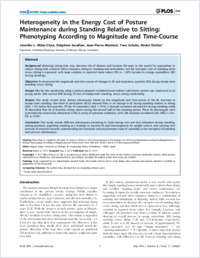Heterogeneity in the energy cost of posture maintenance during standing relative to sitting: phenotyping according to magnitude and time-Course
- Miles-Chan, Jennifer L. Department of Medicine/Physiology, University of Fribourg, Switzerland
- Sarafian, Delphine Department of Medicine/Physiology, University of Fribourg, Switzerland
- Montani, Jean-Pierre Department of Medicine/Physiology, University of Fribourg, Switzerland
- Schutz, Yves Department of Medicine/Physiology, University of Fribourg, Switzerland
- Dulloo, Abdul G. Department of Medicine/Physiology, University of Fribourg, Switzerland
-
31.05.2013
Published in:
- PLoS ONE. - 2013, vol. 8, no. 5, p. e65827
English
Background: Reducing sitting-time may decrease risk of disease and increase life-span. In the search for approaches to reduce sitting-time, research often compares sitting to standing and ambulation, but the energetic cost of standing alone versus sitting is equivocal, with large variation in reported mean values (0% to > 20% increase in energy expenditure (EE) during standing).Objective: To determine the magnitude and time-course of changes in EE and respiratory quotient (RQ) during steady-state standing versus sitting.Design: Min-by-min monitoring using a posture-adapted ventilated-hood indirect calorimetry system was conducted in 22 young adults with normal BMI during 10 min of steady-state standing versus sitting comfortably.Results: This study reveals three distinct phenotypes based on the magnitude and time-course of the EE response to steady-state standing. One-third of participants (8/22) showed little or no change in EE during standing relative to sitting (ΔEE < 5%; below first quartile). Of the 14 responders (ΔEE 7–21%), 4 showed sustained, elevated EE during standing, while 10 decreased their EE to baseline sitting values during the second half of the standing period. These EE phenotypes were systematically mirrored by alterations in RQ (a proxy of substrate oxidation), with ΔEE inversely correlated with ΔRQ (r = 0.6–0.8, p < 0.01).Conclusion: This study reveals different phenotypes pertaining to both energy cost and fuel utilization during standing, raising questions regarding standing as a strategy to increase EE and thermogenesis for weight control, and opening new avenues of research towards understanding the metabolic and psychomotor basis of variability in the energetics of standing and posture maintenance.
- Faculty
- Faculté des sciences et de médecine
- Department
- Département de Médecine
- Language
-
- English
- Classification
- Biological sciences
- License
- License undefined
- Identifiers
-
- RERO DOC 32378
- DOI 10.1371/journal.pone.0065827
- Persistent URL
- https://folia.unifr.ch/unifr/documents/302912
Statistics
Document views: 91
File downloads:
- dul_hec.pdf: 130
